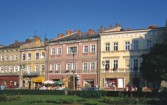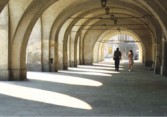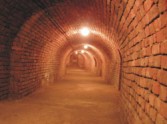- Atrakcje turystyczne
- Informacja turystyczna
- Mapa Jarosławia
- Przewodnicy
- Baza noclegowa
- Gastronomia
- Komunikacja
- Postoje Taxi
- Stacje paliw
Mini guide part 3
It is worth seeing
A mini guide to Jarosław

On the eastern frontage of the marketplace, you will find a building called the "Marysieńka's house" with a classicising façade to be found nowhere else in Jarosław. This burgher house owes its name to the co-owner of Jarosław - Maria Kazimiera Sobieska. The building houses the Association of the Enthusiasts of Jarosław, which has had great merit for the city.
Continuing your walk, you should take a tour of the Rydzikowa burgher house - a representative example of a building in the "Jarosław style" known for a shed - a kind of internal yard - lightened by windows leading over the roof of the superstructure. This type of burgher houses was adapted to the requirements of the large-scale trade activity and refers to typical oriental houses called "fonduku". The cellars also had their role to play in the commercial activity: they often have as many as three storeys and can be found beneath all buildings in the Old Town area as well as outside of it. These cellars were used as warehouses for storing goods brought for the Jarosław fairs.

In the Rydzikowa burgher house, you will discover the Underground Tourist Route named after Prof. Feliks Zalewski. This route consists of a system of pathways and chambers adapted for tourists. It has a total length of 150 metres and the lowest storey is located at a depth of around 8.5 m.
After leaving the Route and crossing the Marketplace, on the western side, you will notice the large, empty St Michael square (plac Św. Michała), where, in the past, a parish church and a cemetery were situated. During its long history as a multicultural city, Jarosław has been inhabited by people of different religious convictions.
There were many temples in the past. The parish church was among the oldest of them, but unfortunately it has not been preserved until this day. This was a marvellous church, originally constructed in a Gothic style and placed under the invocation of All Saints. In AD 1523, it was elevated to the rank of collegiate church. The church, with the adjoined chapels, the founder's chapel and a tower almost 60 metres high crowned in the first half of the 1 th century with a statue of St Michael, dominated over the whole city. It was pulled down because of its bad condition at the beginning of the 19th century.

In the vicinity of the square, you will see Opolska Street, in the past called Żydowska (Jewish) and later Kozia (Goat) Street. The synagogue located in this street was built in the beginning of the 19th century and functioned until the outbreak of World War II. It was reconstructed after the damages it suffered during the war and is now being used by the Artistic School Complex and the State Vocational School.
Opposite the synagogue, in a small square, stands a spearman - a small wooden monument founded by the Hungarian nation and dedicated to the memory of Leon Czechowski, a hero of Polish and Hungarian insurrections.
Węgierską (Hungarian) Street starting next to the monument will take you to a reconstructed fragment of the Renaissance Cracow Gate (Brama Krakowska) and to the city defensive walls with a moat. The Renaissance Cracow Gate, which endured until the turn of the 18th - 19th century, was used to secure the city and was open for merchants and other friendly guests.
Krystyna Kieferling, Zofia Kostka-Bieńkowska




















